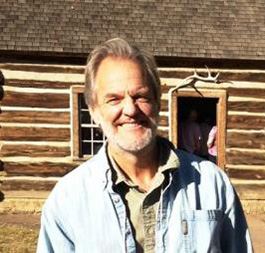Mark van de Logt: Between the Floods: A History of the Arikaras
June 11, 2025 by David
Filed under Non-Fiction, WritersCast
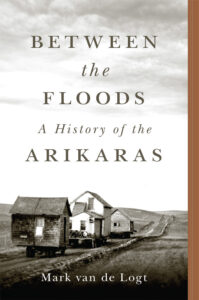 Between the Floods: A History of the Arikaras — Mark van de Logt — University of Oklahoma Press —Paperback — 9780806194905 — 384 pages — $29.95 – October 1, 2024 – ebook versions available at lower prices
Between the Floods: A History of the Arikaras — Mark van de Logt — University of Oklahoma Press —Paperback — 9780806194905 — 384 pages — $29.95 – October 1, 2024 – ebook versions available at lower prices
During the past couple of years, I’ve read several really good books that recast the history of indigenous Americans both prior to, during, and after the invasion of North America by Europeans, first by explorers, fishermen and traders, and later by colonizers. Almost everything most of us learn about this part of the history of the Americas has been told and taught from the European perspective. Academic studies have similarly been mostly conducted by white Americans with indigenous people seen as subjects for interrogation and study by what is proposed to be a more “accurate” form of science, rather than treating indigenous people as equals, with practical knowledge, historical awareness, and actors with full credibility in the telling of their own histories and practices.
Mark van de Logt’s excellent book Between the Floods, purposely challenges the way the history of an indigenous people is studied and understood. Mark gives credence from the outset to the oral storytelling of the Arikara people, that sets forth their history in an oral tradition, which he then supplements with other forms of knowledge to expand them.
The Sahnis, or Arikara, as they are best known, were at one time a powerful independent nation, who likely migrated from the southwest hundreds of years ago, and settled in the Missouri River region in what is now mostly Nebraska (though today, the tribal lands are the Fort Berthold Reservation in North Dakota.)
The Arikaras, like their Hidatsa and Mandan neighbors on the northern plains, were both farmers and hunter-gatherers who thrived as corn growers and successful buffalo hunters. The arrival of Europeans, even hundreds of miles away from them brought pressure on their villages from other indigenous nations, notably the Lakhotas, whose larger population and more successful military forces caused displacements and relocations, and contact with Euro-Americans brought devastating diseases and other problems for the Arikara as well. Their important location on the Missouri River brought them into contact early on with French fur traders, the Spanish, and especially Americans after Lewis and Clark, often with damaging effects on their tribe.
Between the Floods creates a historical narrative of a resilient semi-sedentary people in their migration and settlement as they confront the colonialist era, endure many tribal conflicts, experience terrible diseases, and incorporate horses and metal tools into their culture. Arikara oral traditions and histories provide an entry into their past and current culture that at its core has survived intact despite so much suffering at the hands of their enemies and the conquering American society.
Mark uses information from archaeology, linguistics, and anthropology to enhance native storytelling, and the book is illustrated with Native maps and ledger art, along with historical photographs and drawings. There is no better way to understand this important tribal nation that likely is known to very few Americans today.
This is a terrific book. It’s well written, well-researched, and demonstrates throughout a deep appreciation for the Sahni people, their lifeways, history and traditions. This kind of history-telling is really important not only for the tribe but to all of us who know so little about their past and present lives. And Mark deep knowledge and broad field of study makes him a terrific interview subject.
Mark van de Logt is Associate Professor of History at Texas A&M University of Qatar, teaches in the Department of Modern Languages and Cultures at Radboud University, and is also the author of War Party in Blue: Pawnee Scouts in the U.S. Army (2010) and Monsters of Contact: Historical Trauma in Caddoan Oral Traditions (2018). Between the Floods was awarded the Erminie Wheeler-Voegelin Prize for best book in Ethnohistory from the American Society for Ethnohistory. His current research involves linking oral traditions to historical events. His articles appeared in the “Journal of Military History,” the “American Indian Quarterly,” the “American Indian Culture and Research Journal,” and “Wicazo Sa Review.” He is (co-)editor of the University of Nebraska Press’s “Studies in the Anthropology of North American Indian” series.
There is an interesting interview with Mark about the Arikara scouts for “The Friends of Little Bighorn” here.
Podcast: Play in new window | Download
Surviving Genocide: Native Nations and the United States from the American Revolution to Bleeding Kansas: Jeffrey Ostler
January 12, 2021 by David
Filed under Non-Fiction, WritersCast
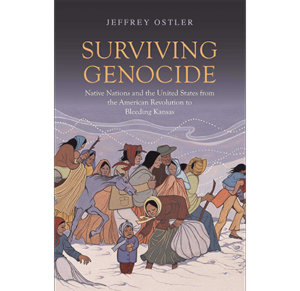 Surviving Genocide: Native Nations and the United States from the American Revolution to Bleeding Kansas – Jeffrey Ostler – 9780300255362 – Yale University Press – Paperback – 544 pages – September 22, 2020 – $25 – ebook versions available at lower prices
Surviving Genocide: Native Nations and the United States from the American Revolution to Bleeding Kansas – Jeffrey Ostler – 9780300255362 – Yale University Press – Paperback – 544 pages – September 22, 2020 – $25 – ebook versions available at lower prices
“A landmark book essential to understanding American history, Surviving Genocide is an act of courage. Ostler’s brilliant concept of reconstructing ‘an Indigenous consciousness of genocide’ is significant for its insight into how American Indians understood, discussed, and resisted genocidal threats to their families, communities, and nations. His modern vocabulary of ‘atrocities’ and ‘killing fields’ is not for political effect but appropriate to the brutal reality of Indian policy in American history.”—Brenda Child, Northrop Professor of American Studies, University of Minnesota
Even though many of us feel we are familiar with the story of the “settling” of America by Europeans and the dispossession of indigenous people, reading Jeffrey Ostler’s book, part one of a major two-volume history, will educate every single one of us to a better understanding of the full scope of the takeover of a continent by invading Europeans. Conquest and genocide are terms we seem unable to apply to our own history, preferring still a more sanitized version of the centuries long overwhelming of the people who lived here before Europeans arrived in force.
Ostler has spent years of research documenting the governmentally sanctioned use of force to remove or kill the indigenous people who were inconveniently in the way of the relentless expansion of the American republic. In this book he documents the losses from the violence – massacres, destruction of habitat and lifeways, diseases and cultural upheaval suffered sequentially by native peoples for hundreds of years as first colonial settlers and then Americans flooded the continent. This volume covers the story of the eastern United States from the 1750s to the beginning of the Civil War that set the stage for the post-Civil War expansion that is perhaps the better known narrative – buffalo, horses, trains, Crazy Horse and the Lakota being so much a part of popular culture imagery. As Ostler shows, the way this played out was not “inevitable” and Manifest Destiny was neither. The indigenous people were outnumbered, but often not out maneuvered or outwitted, and their ability to survive the nightmares of dispossession and attempted genocide is heroic.
As Americans, it is sometimes difficult to look at our own history with honesty. It is often said that the “original sin” of America is slavery, but I think we must grapple with the actuality that there are two essentially economic-based social and cultural wounds at the heart of the American project. First, there is the forced dispossession of the people who were on the land itself, and second, the forced migration and enslavement of Africans for the benefit of white Americans and their economic development. We must learn as much as we can about the history of the last five hundred years in North America in an unromanticized, clear-eyed effort to fully comprehend what our forebears did in the course of creating the American dream all of us are allowed thereby to enjoy. The truth in all its complexity should serve as counterweight to the false narratives and self-serving images we choose to live by, all created as a form of ongoing social control.
Indigenous people have survived despite the many attempts to extirpate them or to forcibly transform and bend their cultures into the conquerors’ image of what “civilization” looks like. Still, the traumatic effects of conquest need to be recognized, acknowledged and repaired and it would be no small thing to recognize formally that a genocide was in play, with all the social and political results that term carries with it. This book and presumably the subsequent volume in Ostler’s work, should help us move in that direction.
The book is well written, hard to put down and completely engrossing; its authoritative and well-researched approach makes it a powerful document and well worth your time to read.
I’m grateful for Jeffrey Ostler for taking the time to talk to me about this book and for Yale University Press for alerting me to it.
Jeffrey Ostler is Beekman Professor of Northwest and Pacific History at the University of Oregon and the author of The Lakotas and the Black Hills and The Plains Sioux and U.S. Colonialism from Lewis and Clark to Wounded Knee.
Podcast: Play in new window | Download
Ben Goldfarb: Eager: The Surprising, Secret Life of Beavers, and Why They Matter
November 6, 2018 by David
Filed under Non-Fiction, WritersCast
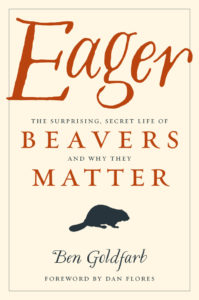 Eager: The Surprising, Secret Life of Beavers, and Why They Matter – Ben Goldfarb – Chelsea Green – 304 pages – Hardcover – 9781603587396 – $24.95 – July 5, 2018 – ebook editions available at lower prices
Eager: The Surprising, Secret Life of Beavers, and Why They Matter – Ben Goldfarb – Chelsea Green – 304 pages – Hardcover – 9781603587396 – $24.95 – July 5, 2018 – ebook editions available at lower prices
This amazing book completely captivated me from beginning to end. Environmental journalist Ben Goldfarb, a Yale Forestry School graduate, is a natural storyteller, and writes with a warm and inviting style. In Eager, he demonstrates how the actions of a single mammal species so thoroughly affects the ecology of rivers and landscapes we have come to take for granted, without understanding the effects of these amazing and inventive rodent environmental engineers.
Beavers have had wide-ranging effects on the landscape for aeons. When Europeans arrived in North America, beavers were everywhere, and the very nature of rivers was completely different than they appear to us today. Slowed in flow, and wildly marshy, because of all the beaver dam building, rivers were rich and varied environments for many species of wildlife, insects and plants.
And yes, beavers are rodents – but very special and important to us all. They were trapped and hunted for their fur in the 18th and 19th centuries. That demand created a hunting and trapping economy that caused beavers to be virtually obliterated from most parts of the United States. And their disappearance literally changed our landscape, allowing the open flow of rivers, thereby causing erosion and the loss of healthy habitat over many years. The river landscapes most of us have seen in our lifetimes simply did not exist 400 years ago.
Beavers have not been appreciated, much less loved, by farmers and ranchers in North America, and typically not understood or appreciated by most of us. But now, in a time of climate change, increasing heat, more drought, and lacking the money or will to build yet more infrastructure, beavers may represent a viable alternative to restoring the health of many river systems around the country.
Ben Goldfarb’s wide ranging and witty book teaches us a great deal about beavers, personalizes their appeal, and shows us why so many people are enthusiastic about beavers now, yet he also shows how difficult it is to change the way we think about beavers and what they can do to make our world a better place. I hope this book adds more than a few beaver enthusiasts to the world, and helps change the way we co-exist with beavers in the future.
It’s impossible to read this book and not come away with a changed perspective. And I really enjoyed speaking with Ben about the book and about his experiences with beavers around the world. Overall, this book is great fun, and I am happy to recommend Eager to readers of all interests.
“Eager takes us inside the amazing world of nature’s premier construction engineer…and shows us why the restoration of an animal almost driven to extinction is producing wide-ranging, positive effects on our landscapes, ecology, and even our economy.”―National Geographic
“This witty, engrossing book will be a classic from the day it is published.” –Bill McKibben, author of The End of Nature
Ben Goldfarb is an environmental journalist and also a writer of fiction. His writing has been published in Science, Mother Jones, The Guardian, High Country News, Audubon Magazine, Modern Farmer, Orion, Scientific American, and many other magazines and journals. He has a masters degree from the Yale School of Forestry and Environmental Studies, and was a 2018 North American Congress for Conservation Biology journalist fellow. You can learn more about his work at his website here.
If you are interested in learning more about beavers or becoming a beaver supporter, there are many organizations around the country. The Beaver Institute is a good one to start with.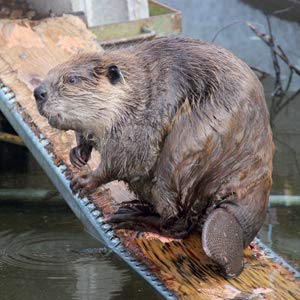
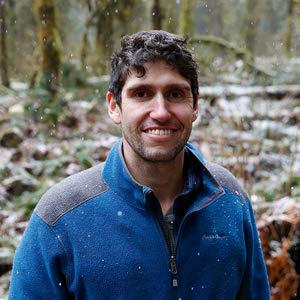
Podcast: Play in new window | Download


